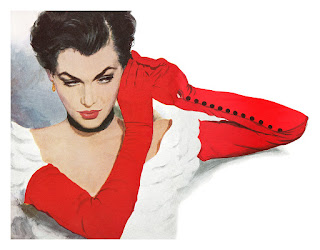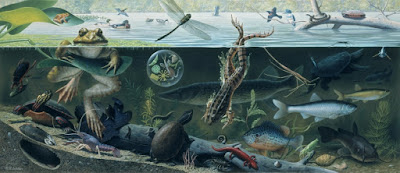 |
Menzel, The Interior of the Jacobskirche at Innsbruck, 1872, 15 3/4 × 10 5/16 in.
|
William Trost Richards (1833-1905) American landscape painter who often painted small works on tone paper. He was equally competent in oil.
Thomas Moran (1837-1926) Moran painted in oil in his studio work, but brought gouache on location to the American West with some of the first survey teams.
Fidelia Bridges (1834 - 1923) American student of Trost Richards, who painted sensitively observed close-ups of plants.
Albert Beck Wenzell (1864-1917) Belle Epoque illustrator of society life who often worked in black and white.

Stepan Kolesnikov (d. 1955) Russian painter of solid peasants and spindly trees.

Eugène Galien-Laloue (1854-1941) French boulevard painter during la Belle Époque. He painted scenes of bustling streets at twilight. They may have been painted by formula, but it was an impressive formula!
 |
| Leaves watercolor and gouache 8 5/8" x 6 3/4" |

Stepan Kolesnikov (d. 1955) Russian painter of solid peasants and spindly trees.

Eugène Galien-Laloue (1854-1941) French boulevard painter during la Belle Époque. He painted scenes of bustling streets at twilight. They may have been painted by formula, but it was an impressive formula!
Albert Brenet (1903-2005), a French illustrator specializing in trains and ships.
Coby Whitmore (1913-1988) Mid-century style-setting illustrator, always innovative with his compositions.

Harry Anderson (1906-1996) known on this blog for his magazine illustrations of women and children, he painted in tempera—here's one of his plein-air landscapes.
Ned M. Seidler (d.2007) was one of the natural history illustrators for National Geographic and the U.S. Postal Service in the 1970s, often compressing a whole ecosystem into a single picture.
 |
| Coby Whitmore, 1950, For the story Heartbreak by A. Barke |

Harry Anderson (1906-1996) known on this blog for his magazine illustrations of women and children, he painted in tempera—here's one of his plein-air landscapes.
 |
| Freshwater Pond Life, ca. 1970. 12 ½ x 28 ½ inches |
Art Fitzpatrick and Van Kaufman. Known as "Fitz and Van" this team painted car ads for Detroit, with consummate control over craft.
Carl Evers (1907-2000) German-born artist specializing in ships and water.
 |
| Leynnwood ‘Memphis Belle’, a Boeing B-17F. |
Syd Mead (born 1933) The combination of Ridley Scott's dystopian vision and Mead's sense of believable detail made the art for Blade Runner some of the finest concept art of all time.
I know I've left out a lot of others, but go ahead and mention them in the comments. Thanks, Charley Parker, Armand Cabrera, and all the others on Facebook who reminded me of some names I had forgotten.















20 comments:
i wonder if that mastery of gouache automatically leads to mastery of oil as well.
Though there are some differences, the overall system of application between the media seems comparable to me.
Like in Menzels case.
Did you know that Menzel actually had a growth hormone deficiency so to speak and was amazingly short.
Bye from Germany
I had Jack Leynnwood as an instructor at Art Center. I remember he used the term "idolistic" a lot in referring to drawing and painting fashionable people. He had Bob Peak as a guest in class one day. What a memorable day that was for me. I was the only one that had the nerve to approach him
after his talk and get his autograph. I treasured that autograph for a long time. I wonder if you had Leynnwood for any classes.
Bron, I had Jack Leynnwood for just one day-long seminar. I sat mesmerized as he painted a demo of a red sports car. He mixed a bright violet color and said it would be the color of the top of the hood reflecting the sky. I thought "No way is that color going to work." Then he put it on and BANG! The whole thing came to life.
When describing the work of Eugène Galien-Laloue, you mention that "they may have been painted by formula." Could you please elaborate on this?
Noor, If you look at a lot of examples his work, they look a bit like they were made according to a standard recipe for color and composition.
You listed some of the best in gouache, many of my favorites. Although primarily casein John Berkey also worked in gouachesome too. As a kid I built plenty of models and sometimes bought them just for the box paintings. Then I went to Art Center and had Jack Leynnwood for an advertising storyboard marker class. That was a thrill of course and he often talked about painting them. In class he taught us how to use great economy in telling the story in marker, really distilling each panel down to its most essential. One of the best and most enthusiastic of the instructors I had.
Lots of people seem to favour Eugène Galien-Laloue, but it strikes me that he was heavily influenced by the 'painter of Paris', Luigi Loir, my favourite painter of the city. Luigi also did lots of gouache paintings, although it's not easy to find much of his work on the Internet. Here's one example : http://media.mutualart.com/Images/2009_07/25/0192/568705/081b01cc-e7da-47f2-8a87-72201f28d067_g.Jpeg
Some outstanding talent amongst your list James.
Some really astonishing artists. I'd like to mention the hungarian/italian illustrator Ferenc Pinter. I guess he isn't very well known outside Italy, but he was a fantastic artist. He mixed different techniques very freely, but the paintings made with gouache should be easily recognizable (he used neither oil nor acrylics, as far as I know). A sample page of a website on him:
http://www.ferencpinter.it/page29/page15/page15.html
(please notice that in Italian we use the word "tempera" for gouache too, not only for "egg tempera").
I think Laloue's formula so to speak was that he drew street scenes from life and composed his paintings in his studio. I believe he planned out his scenes in perspective, deciding on the vantage point and preparing converging lines (the same way Mr. Gurney did in the painting of the Citgo station). Another point is how he works out the architectural lines which give an underpinning structure to the...structures. I've often marveled at his lines, he must have used an aid, same at Mr. Gurney does in the Liquors demo (also there are blog posts on Gurney Journey concerning aids to achieve straight lines and steady your hand above the work). The reason Laloue is one of MY personal favorites is the balance of representation on the one hand with freedom and spontaneity on the other; nothing is ever labored, yet it all reads well.
Register another vote for Ferenc Pinter. His work differs from these artists in that he subordinated detail to design...the result is brilliant. Definitely should be better known in the English-speaking world. I did a blog post showing some of his work:
http://smurfswacker.blogspot.com/search/label/Ferenc%20Pinter
Walter, I don't know Eugene's gouache painting methods, though it does look like he reestablishes some of his lines in pencil over the gouache, and the lines look freehand. Once you have an eye line established and you know your vanishing points it is not so difficult to relate them to a common VP without the use of any sort of aid. It is also possible he lightly established a basic perspective grid with a ruler of sorts, painted over it and reestablished some of the lines/edges freehand to make it a little less mechanical.
When I wrote Gouache for Illustration, the publisher (Watson-Guptill) treated the medium like an oddity with a limited market. Over the years, people like you have done a great deal to make gouache appeal to a wider audience. Nothing could make me happier than to see this medium get the recognition and use it deserves.
My impression was that nearly all the illustrators used gouache because it photographed well. But for those who don't know of him, check out Charles Burchfield. And wasn't Macintosh gouache too?
This has been (another!) really great post and thread, with a lo of the artisits mentioned being new to me. I would like to suggest Mathurin Meheut- I dont know if he is well known in the US, but is certainly highly regarded in France.
Karl Smith, thanks for the mention of Mehuit. I believe he also published a good book of animal drawings that you can get from Dover.
Freb, thanks for mentioning Burchfield and MacIntosh. I realize I left off a lot of architectural illustrators who used gouache.
Thanks, Rob, that means a lot coming from you, and I love your book. I'm also glad to see gouache making something of a comeback.
I didn't know about Ferenc Pinter, so thanks, Mario and Smurfswacker.
Walter, I agree, I love Laloue's paintings, whatever their methods, and agree that Loir and Cortes are worth checking out, too. Loir had a lot of color schemes and approaches, and Charley Parker did a nice post about him recently on Lines and Colors.
David, I wasn't aware John Berkey was using gouache; I thought it was a form of casein he had developed himself. But I could be wrong. Anyway, his paintings have a very "gouache-like" look.
Yeah, Berkey worked mostly in casein as you noted. I went back and looked at the book I have on him and there are a few in there done in gouache although not as many as I originally thought.
Do you think the piece by Troost Richards is all gouache--or just watercolor mixed with white gouache?
Have you considered any medieval manuscript illuminators? Maybe the Limbourg Brothers?
Whilst not fine art, Frank Hampson produced some really stunning comic and illustrative work for The Eagle.
On similar lines to the Leynnwood image, in the UK we had a comic illustrator called Frank Hampson who did beautiful covers and centre spread illustration for The Eagle.
Post a Comment